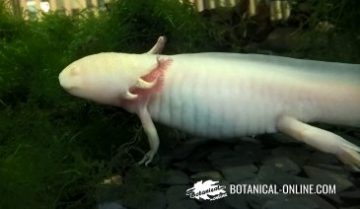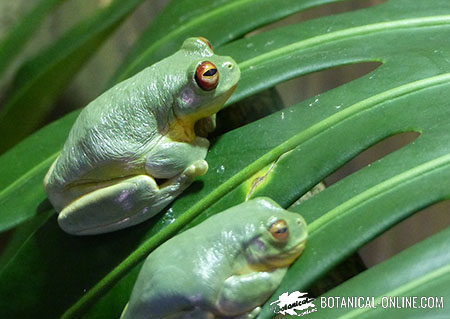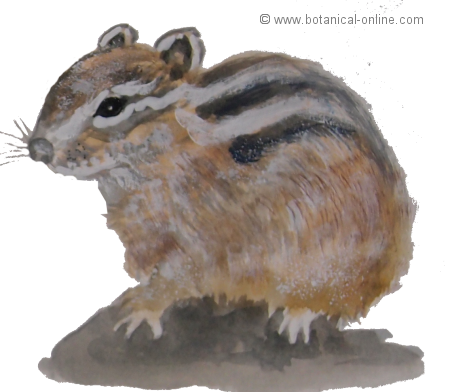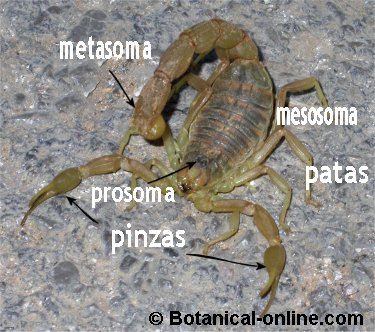Contents
What are axolotls?
Characteristics of axolotls
Common names: Axolotl / Mexican walking fish
Scientific name: Ambystoma mexicanum
– Scientific classification:
Class: Amphibia
Order: Urodela
Family: Ambystomidae
Features:
- Length: 25 – 30 cm.
- Habitat: Oxygen-rich waters.
- Geographic range: On Xochimilco lake, in Mexico City (Mexico).
- Food habits: Carnivorous (aquatic insects, crustaceans, small fish and their eggs).
- Behavior: Solitary, aquatic, nocturnal.
- Reproduction: Breeding period: March – June. Egg-lay: 100 – 800 eggs. Sexual maturity: 12 months old. Sexual dimorphism.
- Enemies: Mainly wading birds. At present also exotic fish.
- Lifespan: 5 – 15 years.
Physical description of axolotls

Axolotls are Mexican amphibians related to amphibian species belonging to order urodeles, like salamanders. These animals have the peculiarity that they do not undergo metamorphosis like the rest of amphibians.
Axolotls color is dark brown, gray or nearly black, with dark spots, although in captivity there are many varieties. In adult phase, they have a powerful tadpole-like tail and little developed extremities, with a prominent, wide and flat head.
Their three pairs of gills, of feathery appearance, are characteristic of axolotls. These animals are the largest members of their family group. They usually measure about 20 cm long, although there are individuals that exceed 30 cm. It has been seen specimens that measured more than 40 cm .
Axolotls retain several larval characteristics in the adult stage, such as three pairs of gills.
What do axolotls eat?
Axolotl like the rest of amphibians are carnivorous species and they feed on aquatic invertebrates, such as insects and mollusks.
In addition to fish, they swallow with great voracity, aided by sensitive papillae to detect their preys.
This amphibian species is cannibal and its larvae can be prey of more developed members of the same species.
Axolotl reproduction
Females differ from males on having a stubby body and a smaller cloaca.
These amphibians have as a particular feature that they reproduce without reaching the adult stage, because they are said to be neotenic animals. That is because axolotls reach adulthood and reproduce while they are in the larval stage.
These amphibians reach sexual maturity after 6 months or from 1 year old.
Individuals of both sexes perform a mating ritual in which the sewers are hit, as they move in circles. This maneuver is carried out by males who wave the back of their body, to which females add. Finally, axolotl males deposit several capsules with spermatozoa, called spermatophores, waving their tail hard.
Axolotls reproduce in spring, from March to June, by means of eggs, in number from 400 to 1000, which they deposit in the vegetation or other elements of the substrate. After about 2 weeks or a little less babies are born. What triggers the start of reproduction is the arrival of good weather, that is to say, longer days and higher temperatures.
Where do axolotls live?
Axolotls are endemic amphibian species from Mexico, which means that they can only be found in this country.
We can only see them in the freshwater lake, called Xochimilco, nowadays in the form of canals and lagoons, and once again in the extinct Chalco lake, both in the Valley of Mexico, where the metropolitan area of Mexico City is located.
Axolotl enemies
The main enemies of these amphibians are waterfowl, such as herons, although since the 70s they have to compete with two exotic fish species, introduced by humans as a fishing resource.
Exotic fish species with which axolotls can compete are Nile tilapias, of African origin, and carps, of Asian origin. These fish devour eggs and larvae of axolotls and compete with the adult specimens for food.
Curiosities about axolotls
Although this salamander species does not undergo metamorphosis naturally, it can be induced by adding thyroxine hormone in water.
Several axolotl relatives also have permanent gills, like Anderson’s salamanders or Taylor’s salamanders. Therefore, these animals are also sometimes referred to as axolotls, although, strictly speaking, only Ambystoma mexicanum is a true axolotl species.
Axolotls are bred in captivity as a laboratory animal, subject to experimentation, and as a pet animal.
There are many varieties of axolotl species: albino (golden with red eyes), melanoid (almost black), leucistic (white with black eyes) …
These salamander species have a great power of body regeneration. If they lose a limb or even a gill or other part of their body, they are able to regenerate it over time.
![]() More information on other wild animals.
More information on other wild animals.







